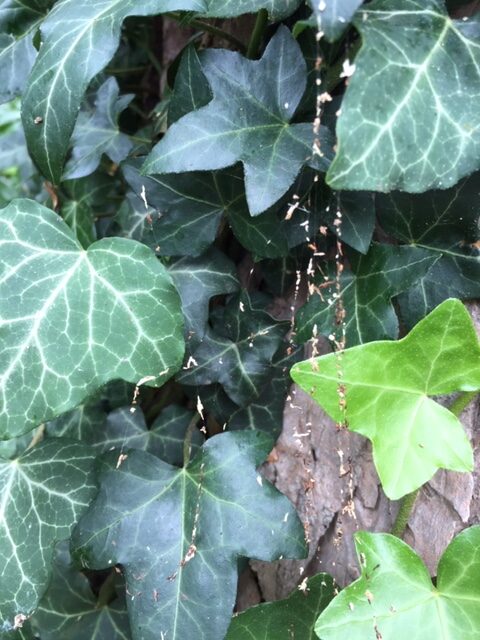
I have a very shady front garden in central Toronto. In recent years, my hydrangeas have been attacked by what I think are spiders (I’ve never actually seen them) that make webs inside the hydrangea leaves so that the leaves curl tightly around the webs. See photos 1312 and 1313.
This year, the webbing has spread throughout the garden, especially affecting my English ivy, which grows as ground cover and also climbs up my very old silver maple. See photos 1307 and 1308.
Do you know what is making these webs, and how I can solve this problem?
Thanks very much for your advice!
Liz Addison
Thank you for contacting Toronto Master Gardeners.
The webs are likely caused by spider mites, very small insects that feed by sucking the green chlorophyll from the leaves. With a hand magnifying lens, you may be able to see them on the underside of the leaves of infected plants.
In small numbers, spider mites are hard to find and damage is minor. However, under warm and dry conditions such as we’ve had for much of this summer, they multiply rapidly. When they feed by the hundreds, they will spin webbing over the surface of the leaves and stems on which they are feeding. This is what you are seeing. The small mites look like specks of dust moving along the webs.
Gray-colored spots on the leaves, called stippling are signs of a mite infestation. Eventually, all the feeding causes the leaves of infected plants to dry and drop off of the plant.
One of the easiest methods of mite control is to wash the plants with a pressurized spray of water. Be sure to spray the underside of the leaves which is the area that spider mites prefer. This should be repeated regularly until you notice a decrease in the spider mite population.
Insecticidal soaps may be effective against spider mites. Be sure to closely follow the manufacturer’s directions if you opt for this approach.
Mite control measures include keeping plants healthy by regular watering, mulching and soil amendments. Also, keep dust levels (which mites favour) under control by cleaning up dust on garden hardscaping, removing dead plant material and maintaining adequate soil moisture.
https://www.cleveland.com/insideout/2011/01/how_to_get_rid_of_spider_mites.html
https://homeguides.sfgate.com/hydrangea-pests-spiders-64099.html

